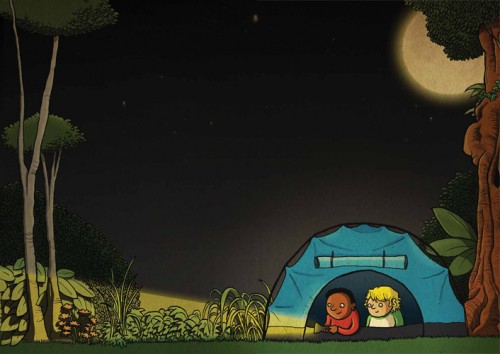What's that coming over the hill? It's just Pie Corbett and his latest story writing class about things that go bump in the night...
Kev’s mum eyed us both. “Ok, but no fooling around,” she muttered, as she turned up the TV. It was Neighbours and for the next half hour total silence would be demanded. Lugging my dad’s tent between us, Kev and I sneaked out of the back door. At long last, we had permission to spend the night camping out, even if it was only at the bottom of Kev’s garden.
Four hours later, we were snuggled into our sleeping bags. Already the sun had dipped over the horizon and the shadows were growing longer. Kev turned on his torch and we stared out across the garden at the house. Each room was lit up with the lights glowing like yellow pumpkins. However, down at the end of the garden where we were, it was getting darker and darker as if we were sinking into a deep pit. Stars came out like tiny silver studs. The moon cast an eerie, silver light over the garden and it grew colder.
Kev zipped up the tent flap and we chatted for a while. I could just see my digital watch giving off a strange, green glow. It had luminous numbers which meant that you could sometimes see them in the dark. Kev had just told me a joke about a man with a dog that wore brown shoes when we first heard it. A strange scratching noise coming from just outside the tent. We froze. What on earth could it be?
Then it came again. Something or somebody was moving along the side of the tent towards the entrance. It was making a scraping noise like somebody’s last rasping breath! There was no escape. All we could do was lie there waiting. Terrified, both of us ducked down deep into our sleeping bags and waited. My heart thumped.

Then Kev really surprised me. Cautiously, he reached out and pulled the flap down. There was a sudden rush of cold air and we stared out. His torch flickered on. Its beam stabbed the darkness, picking out the intruder like a spotlight. It was… a hedgehog! Taking one look at us with its tiny, black, button eyes, it sniffed and trundled off up the garden, snorting like a fat, waddling hairbrush!
The next morning, Kev’s mum treated us to bacon and eggs. “Alright were you, Kevin?” she asked as she spread some butter onto our toast.
“No probs,” replied Kev as if it had been plain sailing. His mum took another look at her son and raised an eyebrow. I could see that she wasn’t fooled!
Get a whiteboard-friendly version of Pie’s story…
If you would like to share this story with your class on the whiteboard or view more of our Pie Corbett resources, please click here
This story is built around a simple idea. The main characters go to a setting that is slightly out of the ordinary. At first everything is OK but then they hear a noise. What could it be? The characters react and are obviously afraid – especially as whatever is making the noise gets closer and closer. The story ends with the discovery that it wasn’t anything really to be worried about but something quite ordinary.
Loiter with the story for at least two or three days, if not longer. This will help the less confident internalise the patterns. Make sure that they have heard the story being read and read it themselves as often as possible. Display it on the interactive whiteboard so that it can be seen by everyone. deepen understanding with the following activities:
• hot seat both the boys and then mum;
• in role as either boy, write a diary entry for the event.
• Role play being in the tent and chatting then at a certain point ‘freeze’ and react in hushed voices to the sound effect;
• draw a graph showing the ups and downs of Kev’s feelings during the story – add quotes from the tale;
• make a list of ‘sound effect’ words, e.g. scratch, scrape, screech, snarl, hiss, moan, groan, rattle, gasp, grunt…
• recount the story from different angles – how would the main character tell what happened – how would Kev’s version vary?
• What or who might be out at night making a noise?
• Use images of night scenes to write short descriptions of the night – including similes for the night, moon, stars, darkness and shadows.
I would begin by ‘boxing up’ the story to show what is happening in each paragraph. This can then be used as a basis for a new version, e.g. To help the children write a version of the story, try the following ideas:
• Make a list of possible ‘settings’ that could be used. It helps if children either use a place that they know well or use an image to look at.
• Begin by creating storyboards so everyone draws a cartoon version of their plot, with a box for each paragraph.
• Use the storyboards for an initial telling of the stories with children working in pairs.
• Plan a class version using a storyboard. Turn this into a simple planning grid that can be used to capture helpful words and phrases.
• Stage the writing each day so that you can use shared writing to model a paragraph before the children attempt their own version.
• Work from the reading into the shared writing before the children have a go themselves.
• Think about how the characters might feel and then decide how they would behave.
• Avoid too much dialogue.
• Pitch the shared writing just above the level that the children are working at.

Teaching five year olds to talk
Ace-Classroom-Support
Should you let educational researchers into your classroom?
Ace-Classroom-Support
